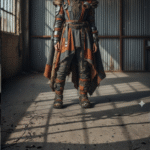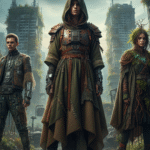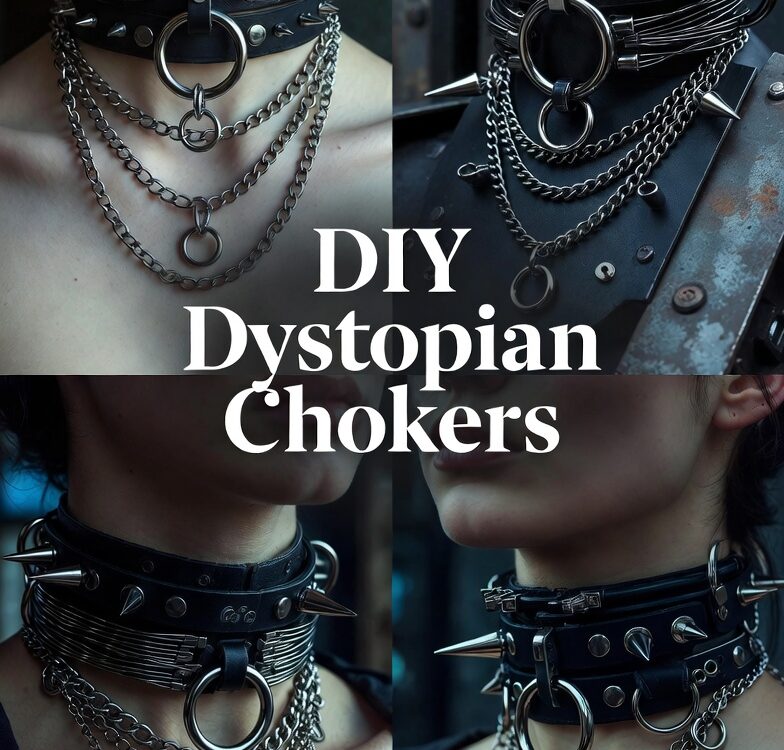
Recycled Dystopian Fashion: A Sustainable Twist on Post-Apocalyptic Style
October 16, 2025
Weathered, Worn, and Woke: The Rise of Eco-Dystopian Fashion
October 18, 2025The glint of polished brass and the hiss of steam power a world of intricate machines. Yet, beneath the veneer of Victorian elegance and technological marvel, a darker reality festers. This is the compelling intersection of two powerful genres: the steampunk dystopian mix. It’s a subgenre that marries the retrofuturistic aesthetic of steampunk with the oppressive social and political structures of dystopian fiction, creating worlds that are as fascinating as they are terrifying.
This unique blend offers a rich canvas for storytelling, exploring themes of technological overreach, class struggle, and the loss of individuality against a backdrop of clockwork automatons and gaslit alleyways. We will delve into what defines this hybrid genre, examine how its core elements work together, and look at prominent examples that have brought these gritty, gear-driven worlds to life.
What Defines Steampunk?
Before we can merge these worlds, it’s essential to understand their individual components. Steampunk is a subgenre of science fiction inspired by 19th-century industrial steam-powered machinery. It imagines an alternate history where Victorian-era technology continued to advance, leading to fantastical inventions like steam-powered airships, clockwork robots, and elaborate analytical engines.
Key Characteristics of Steampunk:
- Aesthetic: The visual style is a hallmark of the genre. Think brass, copper, wood, and leather. Goggles, corsets, top hats, and intricate mechanical accessories are common fashion elements. The architecture and technology feel both ornate and industrial.
- Technology: Everything is powered by steam. This analog technology is often oversized, noisy, and visually complex, with exposed gears, pipes, and pressure gauges. It’s a celebration of invention and mechanical ingenuity.
- Setting: Most steampunk stories are set in an alternate version of the Victorian era (1837-1901), often in London, but can also be found in settings like the American Wild West or other historical contexts reimagined with steam technology.
- Themes: At its core, steampunk often carries a sense of optimism, adventure, and exploration. It celebrates human creativity and the spirit of invention.
What Defines Dystopia?
Dystopian fiction, on the other hand, presents a vision of the future that is anything but optimistic. It explores societies that appear perfect on the surface but are deeply flawed and oppressive underneath. These stories serve as cautionary tales, warning against the dangers of unchecked power, social conformity, and technological control.
Key Characteristics of Dystopian Fiction:
- Control: A central element is the method of control used by the ruling power. This can be through corporate, bureaucratic, technological, or totalitarian means. The population is often manipulated and subjugated.
- Loss of Individuality: Citizens are expected to conform to the state’s rules and norms. Freedom of thought, expression, and personal choice are suppressed or eliminated entirely.
- Environmental or Social Disaster: Dystopian worlds are often the result of a past catastrophe—war, plague, or environmental collapse—which the current regime used to justify its rise to power and the implementation of its oppressive system.
- A Glimmer of Hope: Most dystopian narratives feature a protagonist who questions the society they live in. This individual’s struggle to reclaim their freedom or expose the truth provides the central conflict and a ray of hope.
The Perfect Storm: Crafting the Steampunk Dystopian Mix
When you combine these two genres, the result is a powerful and evocative narrative landscape. The steampunk dystopian mix takes the adventurous spirit of steampunk technology and twists it into a tool of oppression. The same steam-powered marvels that could represent progress become instruments of surveillance, control, and warfare.
This blend creates a unique tension. The intricate, handcrafted beauty of steampunk technology contrasts sharply with the grim, dehumanizing reality of the dystopian society. An elegant clockwork automaton might not be a helpful butler but a relentless police officer enforcing a curfew. A majestic airship may not be for exploration but for broadcasting propaganda or monitoring the populace below.
How the Elements Combine
The steampunk dystopian mix works so well because the core tenets of each genre can be re-contextualized to support the other.
- Technology as a Tool of Oppression: In a standard steampunk setting, technology is often a source of wonder. In a dystopian context, this technology becomes sinister. The very machines that symbolize human ingenuity are used to strip away humanity. The industrial revolution’s dark side—polluted skies, brutal working conditions, and a widening gap between the rich and poor—is amplified and becomes the foundation of the social order.
- Class Struggle Amplified: The Victorian era was already marked by rigid class structures. A steampunk dystopian mix exaggerates this divide. You have a wealthy elite living in opulent, high-tech towers, powered by clean steam, while the working class toils in the grimy, polluted underbelly of the city, keeping the gears of the oppressive state turning. This creates a visually and thematically rich conflict.
- Aesthetics of Decay: The typical polished brass and gleaming wood of steampunk can be replaced with rust, soot, and decay. The aesthetic reflects the moral and social corrosion of the society. The world is a pressure cooker, both literally and figuratively, with the constant hiss of steam mirroring the simmering rebellion of the oppressed.
Examples of the Steampunk Dystopian Mix in Media
While not as mainstream as its parent genres, the steampunk dystopian mix has produced some memorable and influential works across different media.
In Literature
- “Leviathan” by Scott Westerfeld: This young adult series presents an alternate World War I. The “Clankers” (German and Austro-Hungarian Empires) use steampunk-style machines of war, like giant walking tanks. While not a pure dystopia, it uses the mechanics of steampunk to depict a world locked in a brutal, industrialized conflict, showcasing how such technology could lead to widespread destruction and authoritarian control.
- “The Diamond Age” by Neal Stephenson: Although often classified as post-cyberpunk, this novel contains strong steampunk elements, particularly in its focus on nanotechnology that allows for bespoke, intricate creations. It explores a society deeply divided by class and access to technology, creating a world with dystopian undertones where one’s place in society is dictated by the tech they can afford.
In Video Games
- “BioShock Infinite”: Perhaps the most famous example of a steampunk dystopian mix. The floating city of Columbia is a stunning marvel of early 20th-century American exceptionalism, powered by “Vigors” and soaring through the clouds. However, beneath this beautiful facade lies a deeply racist, xenophobic, and brutally classist society led by a tyrannical prophet. The game masterfully contrasts its bright, beautiful aesthetic with its dark, oppressive themes.
- “Dishonored”: The city of Dunwall is a grim, plague-ridden industrial metropolis powered by whale oil—a steampunk-adjacent energy source. The city is ruled by a corrupt and oppressive regime, with the player navigating a world of political intrigue, assassination, and social decay. The art style, technology, and atmosphere perfectly encapsulate the gritty feel of a steampunk dystopia.
- “Frostpunk”: This strategy-survival game places you as the leader of the last city on a frozen Earth. You must manage resources and make difficult moral choices to keep your steam-powered city alive. The game forces you to decide how far you will go to ensure survival, often pushing you toward totalitarian laws and oppressive measures, making it a powerful simulation of building a dystopia out of necessity.
Why Does This Subgenre Resonate?
The steampunk dystopian mix connects with modern anxieties. It explores our complex relationship with technology, questioning whether our innovations will liberate us or become new tools for control. The genre’s focus on industrial-era problems—pollution, labor exploitation, and class division—feels remarkably relevant today as we grapple with similar issues in a new technological age.
By setting these struggles in a fantastical, alternate past, the subgenre provides a unique lens through which to examine our own world. It detaches the issues from their immediate modern context, allowing for a more objective and creative exploration of timeless social and political questions.
Frequently Asked Questions (FAQs)
Q1: What is the main difference between steampunk and a steampunk dystopian mix?
The main difference lies in the theme and tone. Traditional steampunk often has an optimistic and adventurous tone, celebrating invention and progress. A steampunk dystopian mix, however, uses the same aesthetic and technology to create a world of oppression, control, and social decay. The technology is not a symbol of freedom but a tool of the oppressor.
Q2: Are cyberpunk and steampunk dystopia related?
Yes, they can be seen as cousins. Both genres explore the impact of technology on society, often with a pessimistic outlook. The key difference is the technological aesthetic. Cyberpunk focuses on futuristic digital technology like cybernetics and artificial intelligence, while a steampunk dystopia uses analog, steam-powered technology from an alternate 19th century. Both often feature a “high tech, low life” dynamic.
Q3: Can a steampunk story have dark themes without being a dystopia?
Absolutely. A steampunk story can be a horror, mystery, or grim war story without being a full-blown dystopia. A dystopia specifically involves a society that is oppressive and controlling, often under the guise of being a utopia. A story could feature monstrous clockwork creations or a gritty, polluted city without having that overarching system of societal control.
Q4: Where is a good place to start if I’m new to the steampunk dystopian mix?
Playing the video game BioShock Infinite is an excellent introduction. It is one of the most well-realized examples of the subgenre, with a compelling story and world design that perfectly illustrate how the utopian promise of a steampunk city can hide a dystopian nightmare.
Final Words
The steampunk dystopian mix is more than just a stylistic mashup; it is a thoughtful and compelling subgenre that leverages the best of both its parent genres. It builds worlds that are visually stunning and thematically deep, filled with intricate machinery and even more intricate social problems. By turning the gears of progress into the mechanisms of oppression, it creates unforgettable stories that challenge us to think about power, technology, and what it truly means to be free. It reminds us that even in a world of brass and steam, the human spirit’s fight against tyranny remains a powerful and timeless tale.



